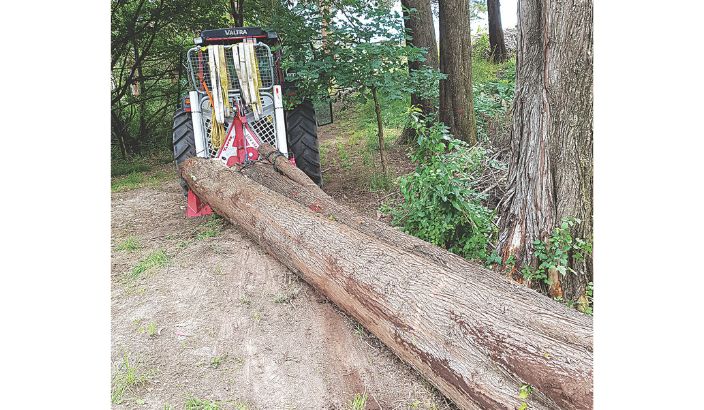Small scale wood milling in Orinoco


Roger May's 70hp Valtra 4×4 tractor fitted with logging winch harvesting Macrocarpa. Photo: Supplied.
Roger May’s 24-hectare property near Ngātīmoti, purchased in 1986, was a patchwork of grass, weeds, and invasive species such as Old Man’s Beard, gorse, and blackberry. At the time, native vegetation was sparse, with only a few fuchsias and a lone tree fern. Roger saw potential in the land and began replanting to restore the ecosystem and protect local waterways.
Roger’s primary goal was to prevent soil erosion and protect the Strachan Stream, which feeds into the Orinoco River. By planting trees in the gullies, he aimed to stabilize the soil and reduce sediment entering the water. Over time, the trees grew well, transforming the land. However, some species, particularly two types of cherry—Prunus avium and Prunus serotina—became overly successful. Sycamores, which spread naturally, also became a nuisance, creating dense carpets in certain areas. Roger now considers these species a bigger problem than Old Man’s Beard.
Roger advises against planting these invasive species, as well as Robinia and Acacia dealbata, which can spread uncontrollably. He stresses that careful selection of tree species is essential to avoid future problems.
Since his initial planting, Roger has expanded his efforts with a mix of native and exotic trees. He recommends tree lucerne (Chamaecytisus palmensis) as a great starting point, as it grows quickly and creates an environment conducive to other trees. Many of the trees on Roger’s property have naturally self-seeded, aided by the birds that frequent the area. With more birds now in the area—kererū, tūī, bellbirds (korimako), and others—native species continue to grow naturally.
In 1986, only a few bird species, such as skylarks and hawks, were present. Today, the property is home to a wide variety of native and introduced birds, thriving thanks to the diverse tree canopy that provides food and shelter.
Roger’s replanting efforts have also paved the way for a small-scale sustainable forestry operation. He runs Tomorrow’s Forests, a consultancy that promotes sustainable forestry practices, focusing on continuous cover forestry. This approach involves selective harvesting and maintaining a canopy, rather than clear felling. Roger believes this method is the future of forestry and is committed to expanding it in New Zealand.
On his property, Roger uses specialized equipment for selective logging, including a 70-horsepower 4x4 tractor with a radio-controlled winch that can pull logs up to 6.5 tonnes. The process is time-consuming but cost-effective. He has also set up a portable sawmill, where timber is milled for use in flooring and cladding. Roger sells the milled timber through TradeMe, where customers place small orders.
Roger May’s 36-year journey in Ngātīmoti has transformed his property into a thriving, biodiverse landscape. His sustainable forestry practices, management of invasive species, and promotion of biodiversity demonstrate his commitment to the environment. Through Tomorrow’s Forests, Roger continues to lead the way in innovative forestry, balancing conservation with economic sustainability.
